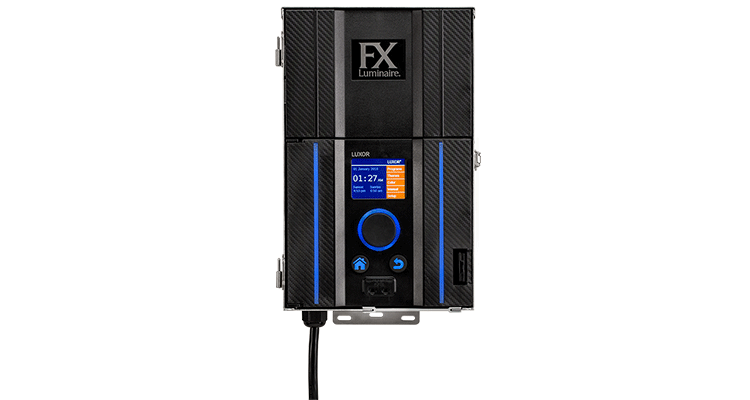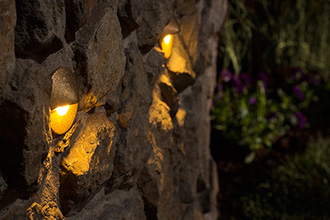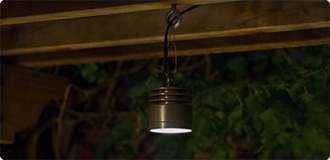MGM Resorts International Elevates the Las Vegas Visitor Experience With Digital Signage
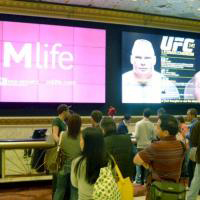 Hotel management spends a lot of time thinking about the guest experience and how to maximize enjoyment during conventions and meetings. One of the key elements of success revolves around communication — presenting the right information to guests at the right time in a format that catches guests’ attention.
Hotel management spends a lot of time thinking about the guest experience and how to maximize enjoyment during conventions and meetings. One of the key elements of success revolves around communication — presenting the right information to guests at the right time in a format that catches guests’ attention.
In Las Vegas, there are many things competing for attention, and capturing viewers’ interests cannot be effectively accomplished with static posters or flyers at the front desk. MGM Resorts International (MGM) is a great example of “too much good stuff,” where guests rarely learned of all the entertainment choices they had at their disposal. Therefore, improving the guest experience became a matter of helping them find just the right activities and hidden gems.
MGM owns and operates some of the most prestigious and well-known hospitality attractions in Las Vegas, including The Mirage, Bellagio, Monte Carlo, New York — New York, Excalibur, Luxor, Mandalay Bay, MGM Grand, The Signature at MGM Grand, Aria, Vdara, Circus Circus and the unique CityCenter. MGM employs a staff of 60,000
and serves millions of guests every year.
VENUE/INSTALLATION: MGM Resorts International Properties, Las Vegas
PROVIDERS: NEC Display Solutions, Itasca, Ill.; Four Winds Interactive, Denver;Richardson Electronics Ltd., LaFox, Ill.; Newmarket Daylight, Portsmouth, N.H.
DATE: April 2009 (ongoing)
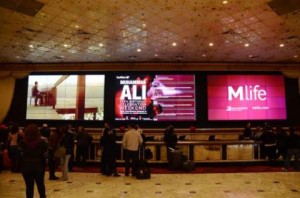
Designed to entertain and educate guests in the lobby, this 4×12 video wall in the lobby of the Mirage displays a Twitter feed for guests with interactive content that promotes high-profile events.
CHALLENGES
In years past, MGM relied on static signs in formats ranging widely from paper posters to etched metal plates. This was less than optimal because of printing costs, lead time, paper waste and personnel required to update static posters. As communication needs increased, adding static signs presented a cluttered look. Furthermore, advertising with static signs wasn’t flexible and didn’t allow for rotating ads or changing content based on time of day. Wayfinding was also a challenge due to the size and unique floor plans of the properties.
In addressing these issues, management wanted to provide guests with on-the-spot directions and suggestions to navigate a bewildering array of dining options, entertainment and meeting rooms. All of that information had to be delivered when and where it was needed, on systems that matched the luxurious décor.
Randy Dearborn, vice president of multimedia for MGM, has played an instrumental role in the development of multimedia technology for the company. As Dearborn sought to identify the properties’ communications challenges, he studied guest patterns and conducted pilot tests of new communications concepts. He looked at utilization of hotel amenities and clubs and studied guest awareness of promotions and nightly entertainment.
“One of the top challenges we wanted to address was making it easy for guests to view dinner options, peruse menus and even make reservations,” said Dearborn. “As guests stroll through the lobbies, this needs to be a simple process that is both inviting and appealing.”
Facing many competing entertainment options, MGM and Dearborn also saw the need to promote in-house clubs, bars and shows, using live video and custom content to best portray the choices and convey the fun atmosphere of those destinations.
“Static posters weren’t giving guests the feeling that our clubs were alive and full of action,” said Dearborn. “We wanted to use video clips to set high expectations and show each venue’s unique flavor to help guests pick the club they would enjoy most.”
MGM also does big business with conventions and needed to set itself apart from the city’s increasing number of venues for ballrooms, events and meetings. Even with good convention space design, there are still challenges for conference attendees to find the next speaker or session. Wayfinding assistance is critical, and because of the continually changing roster of events, static signs were not a good option because guests needed to go the extra step of correlating static maps with printed schedules.
SOLUTIONS
MGM addressed many of its communications challenges by installing a digital signage network, using flat-panel LCD displays from NEC Display Solutions. In all, there are roughly 500 NEC large-screen displays deployed throughout MGM’s properties that range in size from 32″ to 82″. This allows flexible content to be scheduled throughout the hotel with riveting live video in colors bold enough to hold viewer interest.
The in-house multimedia services team is responsible for planning the digital signage deployments, installing hardware and software, and managing day-to day content creation and scheduling. The team relies on Apple hardware and software, including the Mac Mini for players connected to the displays, and a special Mac version of Four Winds software to schedule content on the network of displays.
Menu boards were one of the high-value applications for NEC digital signage, and currently MGM has 20 restaurant touch screens at six properties. NEC’s 40″ LCD displays are fitted with touch overlays for the hotel by Richardson Electronics. Restaurant staff is also able to change specials and line items on the menu in real-time through a simple Microsoft Excel spreadsheet, which then automatically updates the signs without needing to engage the content management team. The next project in the implementation is to allow dining reservations to be made right on the screen, which becomes very helpful to guests in the mornings, for example, when dinner restaurants are not yet open. This capability allows guests to review the menu, examine pictures of the interior and decide in the moment to dine there.
In the casinos, NEC digital signage was installed at the end-caps of rows of slot machines, visible to guests who are following the curving carpet walkways. These screens promote in-house attractions and run advertising, as well as show the increasing jackpot values on progressive slot machines. Enclosures for the displays were carefully considered to give the right appearance, fit and finish. At the entrances to the hotels’ nightclubs are NEC’s 40″, 46″ and 57″ LCD displays. The content includes video of the club experience to help guests think about the night ahead and pick the ambiance that best suits their tastes. The displays run 24/7 in many cases, so professional-grade panels were a critical consideration.
“I love NEC products because they’re rock solid, reliable and have great image quality,” says Dearborn. “I’ve had trouble with other vendors due to poor video scaling and burn-in issues. With NEC, it’s nice to buy something and not have to worry about it.”
As an example, when the new “Lion King” show signage was installed, Dearborn took the designers on a tour of other hotels to show them the problems, such as burn-in, that can occur. As a result, they selected NEC again. As part of the focus on quality, the NEC displays are driven by digital DVI interfaces to create sharp, high-definition images. As newer NEC models became available, MGM began installing them throughout its properties, adding to its existing digital signage.
Another project MGM has undertaken is to dynamically change wayfinding information based on time of day. By doing so, the hotels can highlight activities at the appropriate times, such as the dolphin show during the day and clubs or shows in the evenings.
Within the convention facilities, NEC digital signage also provides wayfinding content in several of the properties. Bellagio, Luxor and other properties have installed wayfinding displays with touchscreen capabilities to help attendees find meeting rooms or navigate the facility. Now, attendees simply touch the screen where they see the words “Map it!” to get custom directions to their events. Content is constantly being updated to tell conference attendees where the next session is located and how to get there. The internal Multimedia Services team accomplished this objective by writing custom software to pull meeting details directly from the [Newmarket] Daylight software system, which is used by MGM to run its facilities.
“In our original pilot tests with digital wayfinding, kids loved it and seniors were less engaged,” said Dearborn. “But in recent months, we have noticed the comfort level has increased dramatically, and more people of all ages are using the touchscreens and enjoying the convenience of our wayfinding systems.”
At the exciting new CityCenter, more than 95 displays are used for interactive wayfinding, such as in the Aria hotel’s convention facility and in the Crystals retail promenade. Displays throughout CityCenter include NEC’s 32″, 40″ and 46″ LCDs, which feature advertising to highlight the shows and entertainment.
The Multimedia Services team has also installed several of NEC’s life-size 82″ displays in the Monte Carlo, visible from the escalator as guests enter from the garage. Four of these panels are side-by-side in portrait orientation to promote in-house attractions, such as the Monte Carlo Brew Pub. For example, one display shows a full beer, the next shows a half beer, and the third display shows an empty beer, with the phrase, “Going, Going, Gone!”
In the lobby of the Mirage, MGM installed a video wall consisting of 48 NEC 55″ ultra-narrow displays. Designed to entertain and educate guests in the lobby, this 4×12 video wall displays a Twitter feed for guests with interactive content that promotes high-profile events such as UFC fights and major sporting events.
At the Mandalay Bay’s Shark Reef, the Multimedia Services team deployed four interactive touchscreens and three 40″ displays to provide guests with educational information about the reef as well as other information about the property.
Turning his attention to the back-of-the-house logistics, Dearborn has implemented a digital signage system specifically for the hotel staff that delivers employee information, such as health benefits, 401K program details, employee discounts and upcoming employee events like blood drives and book fairs. It is known as ME-TV, or MGM Resorts International Employee Television, and includes live data streams to show traffic reports and other useful information.
MGM plans additional implementations of NEC digital signage throughout its properties and continues to test new uses for the medium, including the incorporation of social media. Digital signage may also be used to help the event staff in the employee access areas, with diagrams and pictures on the screens showing room setup for specific meetings.
This case study was reprinted with permission from the Digital Signage Connection and originally appeared here.



